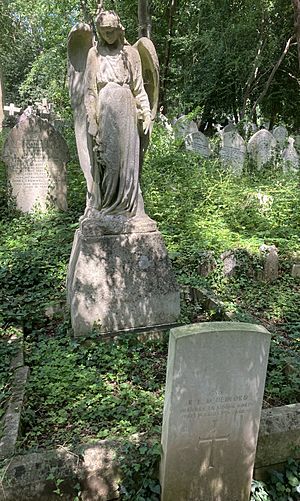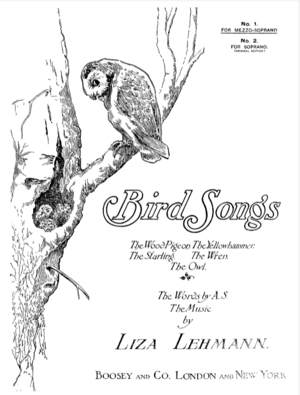Liza Lehmann facts for kids
Liza Lehmann (born July 11, 1862 – died September 19, 1918) was an English singer (a soprano) and a composer. She was especially famous for the music she wrote for voices.
Liza Lehmann studied singing with famous teachers like Alberto Randegger and Jenny Lind. She also learned how to compose music from teachers such as Hamish MacCunn. She started her singing career in London in 1885 and performed in concerts for almost ten years. In 1894, she got married and stopped performing on stage. After that, she focused on writing music. She became well-known for her songs, including many for children. She also wrote music for plays and operas, and even a book about singing. In 1910, she toured the United States, where she played the piano for her own songs during her concerts. She was the first president of the Society of Women Musicians and became a singing teacher at the Guildhall School of Music in 1913.
Contents
Her Life Story
Liza Lehmann was born in London with the full name Elisabetha Nina Mary Frederica Lehmann. Her father, Rudolf Lehmann, was a German painter. Her mother, Amelia Chambers, was a music teacher, composer, and arranger. Liza grew up in a very creative and smart home. When she was young, she lived in Germany, France, and Italy.
She learned to sing in London from Alberto Randegger and Jenny Lind. For composing, she studied with Hamish MacCunn in London, Niels Raunkilde in Rome, and Wilhelm Freudenberg in Wiesbaden.
Liza Lehmann first performed as a singer on November 23, 1885, at a concert in St James's Hall. For the next nine years, she performed in many important concerts across England. Famous musicians like Joseph Joachim and Clara Schumann encouraged her. She stopped performing on stage after her last concert on July 14, 1894. She then married Herbert Bedford, who was also a composer and an artist. After this, she focused on writing music.
In 1910, Lehmann traveled around the United States. She performed her own songs and played the piano for them. In 1911 and 1912, she became the first president of the Society of Women Musicians. She also taught singing at the Guildhall School of Music starting in 1913. In the same year, she wrote a book for singers called Practical Hints for Students of Singing.
Liza and Herbert had two sons. Their older son, Rudolf, sadly died during training in the First World War. Their younger son, Leslie Herbert Bedford (1900–1989), was an inventor. He helped develop radar technology. Leslie was the father of the conductor Steuart Bedford and the composer David Bedford.
Liza Lehmann finished writing her life story in 1918. She passed away shortly after, at the age of 56, in Pinner, Middlesex. She is buried with her husband and father in a family grave at Highgate Cemetery.
Her Music
After she stopped performing in 1894, Liza Lehmann spent the rest of her life composing music. Two years later, in 1896, she finished one of her most famous works. It was a collection of songs for four voices and piano called In a Persian Garden. These songs used words from Edward FitzGerald's version of the Rubāiyāt of Omar Khayyām.
She wrote many other song collections, including:
- The Daisy Chain (1893): These were children's songs for a group of four singers.
- In Memoriam (1899): This was based on a love poem by Alfred Lord Tennyson.
- Bird Songs (1907): The words for these songs are thought to be by Alice Sayers, the family nurse.
Liza Lehmann became known for her art songs (serious songs for trained singers) and parlour songs (popular songs for home entertainment). Many of her songs were for children. Some were sweet and simple, like "There are fairies at the bottom of our garden." Others were more powerful, like "Stars" from The Daisy-Chain. Her song "Ah, moon of my delight" from In a Persian Garden has been recorded by many famous tenors over the years.
In 1904, she was asked to write the music for a musical comedy called Sergeant Brue. This show was successful in London and New York. However, Lehmann was not happy because other composers' music was added to her score. Because of this, she decided not to write any more musicals.
Even so, she composed the music for a comic opera (a funny opera) version of The Vicar of Wakefield in 1906. This opera had some success but did not lead to her writing more comic operas. In 1916, she wrote music for another stage work, an opera called Everyman. This opera was performed by the Beecham Opera Company.
Liza Lehmann, Ethel Smyth, and Maude Valérie White were the leading female composers of songs in England at the start of the 20th century. While they all wrote serious songs, Lehmann and White were especially good at setting lighter words to music. Some of Lehmann's musical ideas, like writing song collections for four voices and connecting songs with piano parts, were common for her time. Even though her pieces were creative, they are sometimes forgotten today.
Her Musical Works
Here are some of the types of music Liza Lehmann composed:
For the Stage
- Sergeant Brue, a musical comedy (1904)
- The Vicar of Wakefield, a light opera (1906)
- Everyman, a one-act opera (1915)
Vocal Music with Orchestra
- Young Lochinvar, for a baritone singer, chorus, and orchestra (1898)
- Endymion, for a soprano singer and orchestra (1899)
- Once Upon a Time, a cantata (a piece for singers and instruments) (1903)
Vocal Quartets with Piano
These are collections of songs for four voices and piano.
- The Daisy-Chain (1893)
- In a Persian Garden (1896)
- Nonsense Songs (from Lewis Carroll's Alice in Wonderland) (1908)
Songs for Solo Voice
Liza Lehmann wrote many songs for a single singer.
- Mirage (1894)
- In memoriam (1899)
- Bird Songs (1907)
- Mr. Coggs and Other Songs for Children (1908)
- There are Fairies at the Bottom of Our Garden (1917)
Other Vocal Works
- Music, When Soft Voices Die, for voice and piano
- The Secrets of the Heart, for soprano, alto, and piano (1895)
- The Happy Prince, a melodrama (a story told with music) (1908)
- Four Cautionary Tales and a Moral, for two voices and piano (1909)
Instrumental Music
- Romantic Suite, for violin and piano (1903)
- Cobweb Castle, for solo piano (1908)
Her Writings
- The Life of Liza Lehmann, by Herself (published in 1919)
See also
 In Spanish: Liza Lehmann para niños
In Spanish: Liza Lehmann para niños




